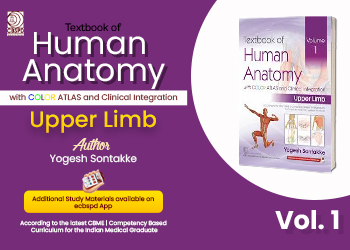Textbook of Human Anatomy with Color Atlas and Clinical Integration Volume 1
in Medical
Created by
Yogesh Sontakke
About this course
Digital Content of Textbook of Human Anatomy is written by Dr. Yogesh Sontakke and Dr Ujwala Bhanarkar – authors of many Best-seller books. This book helps students to fulfil the
requirements as per the latest CBME Guidelines and gives the clinical orientation. The book has concise text with functional correlation, 2350 plus Beautiful Color atlas illustrations,
1050 Line diagrams, 450 Clinical images, 620 Flowcharts, 210 Boxes on important topics and markings for NeXT, MCQ, Viva voce, and Clinical facts;.
Comments (0)
Textbook of Human Anatomy Volume-1 Upper limb hand Written notes
108 Parts
Figure 20.1 Midcarpal and 1st carpometacarpal joints (right, anterior view)
-
Figure 19.26 Relations of wrist joint_ Transverse section passing through the wrist joint (right, superior view)
-
Figure 19.25 Ligaments of wrist joint (right, anterior view)
-
Figure 19.22 Wrist, midcarpal and 1st carpometacarpal joints (right, anterior view)
-
Figure 19.19 Supination and pronation (right)
-
Figure 19.15 Ligaments of radioulnar joints (right, anterior view)
-
Figure 19.7 Relations of elbow joint (right, superior view, section passing through the cavity of elbow joint)
-
Figure 19.6 Radial collateral ligament (right, lateral view)
-
Figure 19.5 Ulnar collateral ligament (right, medial view)
-
Figure 19.2 Articular surfaces of elbow joint (right)
-
Figure 18.17 Anatomical snuffbox (right, lateral view)
-
Figure 18.16 Posterior interosseous nerve (right)
-
Figure 18.15 Course and relations of posterior interosseous nerve and artery (right, sagittal section)
-
Figure 18.13 Transverse section passing through the extensor retinaculum of forearm, through the lower part of radius and ulna
-
Figure 18.2 Muscles of posterior compartment of forearm (right, posterior view) Note_ Supinator muscle is not visible in this vi
-
Figure 17.30 Thenar and hypothenar spaces (right, crosssection of hand, superior view)
-
Figure 17.26 Branches of median nerve in palm (right, anterior view)
-
Figure 17.21 Branches of ulnar nerve (right, anterior view)
-
Figure 17.17 Superficial and deep palmar arch (right, anterior view)
-
Figure 17.13 Interossei muscles (right, anterior view
-
Figure 17.10 Lumbricals (right, anterior view)
-
Figure 17.8 Thenar and hypothenar muscles (right, anterior view)
-
Figure 16.14 Synovial sheaths of the flexor tendons of hand (right, anterior view)
-
Figure 16.13 Digital synovial sheath and mesotendon (crosssection of the digit, superior view)
-
Figure 16.7 Relations of flexor retinaculum (right, cross-section through distal row of carpal bones, superior view). FDS_ Flexo
-
Figure 16.5 Superficial relations of flexor retinaculum (right, anterior view)
-
Figure 15.16 Branches of median nerve
-
Figure 15.15 Branches of ulnar nerve in forearm
-
Figure 15.12 Relations of radial artery
-
Figure 15.8 Flexor digitorum profundus, flexor pollicis longus, and pronator quadratus
-
Figure 15.4 Flexor digitorum superficialis
-
Figure 15.3 Superficial muscles of forearm except flexor digitorum superficialis
-
Figure 14.11 Anastomosis around elbow
-
Figure 14.8 Contents of cubital fossa
-
Figure 14.6 Floor of cubital fossa
-
Figure 14.4 Structures in the roof of cubital fossa
-
Figure 14.2 Boundaries of cubital fossa
-
Figure 13.22 Profunda brachii artery
-
Figure 13.20 Branches of radial nerve in axilla and arm
-
Figure 13.13 Branches of brachial artery
-
Figure 13.5C Schematic representation of muscles in the front of arm
-
Figure 13.5B Schematic representation of muscles in the front of arm
-
Figure 13.5A Schematic representation of muscles in the front of arm
-
Figure 13.3 Transverse section through the distal one-third of arm
-
Figure 12.7 Relations of shoulder joint
-
Figure 12.4 Articular surfaces of shoulder joint
-
Figure 12.2 Articular surfaces of shoulder joint
-
Figure 11.19 Role of scapular anastomosis in establishing bypass circulation from the first part of subclavian artery to the thi
-
Figure 11.18 Scapular and acromial anastomosis
-
Figure 11.16 Axillary nerve
-
Figure 11.15 Intermuscular spaces in scapular region
-
Figure 11.12 Supraspinatus, infraspinatus, teres minor, and teres major (right, posterior view)
-
Figure 11.10 Subscapularis muscle (right, anterior view)
-
Figure 11.7 Musculotendinous (rotator) cuff of shoulder joint
-
Figure 11.3 Deltoid muscle
-
Figure 10.7 Triangle of auscultation and lumbar triangle of Petit
-
Figure 10.5 Levator scapulae, rhomboid major, and rhomboid minor muscles (right, posterior view, trapezius is dissected out to v
-
Figure 10.3 Latissimus dorsi and trapezius muscles
-
Figure 9.6 Erbs point
-
Figure 9.4 Formation and branches of brachial plexus
-
Figure 8.21 Axillary lymph nodes
-
Figure 8.18 Axillary vein_ formation and tributaries
-
Figure 8.15 Branches of axillary artery
-
Figure 8.13 Relations of 3rd part of axillary artery
-
Figure 8.12 Relations of 2nd part of axillary artery
-
Figure 8.11 Relations of 1st part of axillary artery
-
Figure 8.10 Parts of axillary artery
-
Figure 8.9 Contents of axilla
-
Figure 8.5 Cervicoaxillary canal
-
Figure 8.4 Walls of axilla Transverse Section
-
Figure 8.3 Wall of axilla
-
Figure 7.16 Retraction of skin and nipple in carcinoma of breast
-
Figure 7.13 Mammary ridge. In 6th week
-
Figure 7.12 Levels of lymph nodes draining the breast
-
Figure 7.11 Direct pathway of deep lymphatics of the breast through pectoralis major and clavipectoral fascia to apical group of
-
Figure 7.10 Subareolar lymph plexus of Sappey
-
Figure 7.9 Lymphatic drainage of breast
-
Figure 7.8 Blood supply of breast
-
Figure 7.7 Structure of the lobe of lactating mammary gland
-
Figure 7.6 Structure of breast
-
Figure 7.4 Deep relations of breast
-
Figure 7.3 Muscles lying deep to the breast
-
Figure 7.2 Location and extent of breast
-
Figure 6.12 Serratus anterior muscle
-
Figure 6.10 Structures piercing clavipectoral fascia
-
Figure 6.8 Pectoralis minor and subclavius muscles
-
Figure 6.6 Pectoralis major muscle
-
Figure 6.4 Dermatomes of pectoral region
-
Figure 6.3 Cutaneous nerves of pectoral region
-
Figure 6.2 Anatomic reference lines of lateral chest wall
-
Figure 6.1 Surface anatomy of pectoral region
-
Figure 5.5 Attachments on the bones of hand
-
Figure 5.1 Bones of the hand
-
Figure 4.14 Three-point bony relationship of the elbow
-
Figure 4.11 Features of right ulna (right, anterior and posterior views)
-
Figure 4.6 Attachments of radius and ulna
-
Figure 4.5 Attachments of radius and ulna
-
Figure 4.3 Features of right radius
-
Figure 3.9 Ossification of humerus
-
Figure 3.4 Attachments of the right humerus
-
Figure 3.3 Features of the right humerus
-
Figure 2.11 Attachments of right scapula_1
-
Figure 2.10 Features of right scapula_1
-
Figure 2.8 Borders and angles of the right scapula_1
-
Figure 2.6 Ossification of the clavicle_1
-
Figure 2.3 Attachments of right clavicle
-
Figure 2.2 Features of right clavicle
-
Figure 1.1 Parts and bones of upper limb
-

0
0 Reviews







